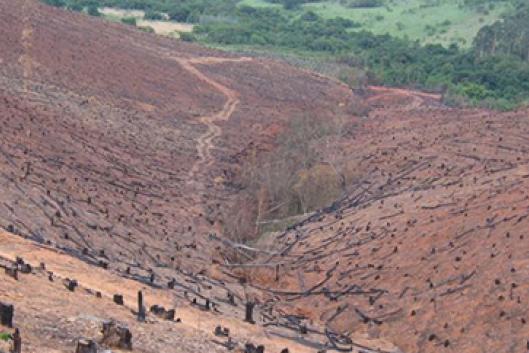While much of the world is caught up in economic and political turmoil, there is a far more serious but less obvious issue. As a slow, almost imperceptible process which is difficult to detect or to measure, water theft is seldom viewed as a high priority crime. Yet, beneath our very noses, vast volumes of water are being misappropriated by “silent” thieves that operate 24 hours a day, 365 days a year. Corporations setting up monoculture plantations are the culprits, but, how can planted trees behave so differently from natural forests? Most people assume that they are the same. This fallacy however has led to a water crisis wherever “fake forests” of alien trees have been established on land once covered by real forests, or biodiverse grassland and scrublands.
This artificial conversion of the landscape has many negative impacts that so-called “foresters” and plantation companies choose to ignore. Despite there being ample evidence, both empirical and scientific, the ugly truth about how monoculture plantations affect water sources and biodiversity has been deliberately obscured by those who profit from it.
In many cases, the effect of water taken by industrial tree plantations can be matched only by the worst drought. Experiments conducted in areas where land was converted to tree plantations have proven that their water consumption can exceed the amount of rain that falls where they stand. This has been demonstrated, for example, in South Africa, by measuring the reduction in stream flow that occurs after grassland catchments have been converted to plantations. Reports by researcher Joan Whitmore (1) describe this effect as “water piracy”, due to its impacts on adjacent land users and downstream ecosystems including wetlands, estuaries and coastal marine habitat.
How this works
Evergreen plantation trees consume water throughout the year, unlike natural vegetation which consumes very little in the dry season. In addition, the dense leafy canopy of these plantations prevents rain water from reaching the soil surface. The combination of evaporation from water caught in their foliage, combined with groundwater drawn up from their roots to their leaves is called evapo-transpiration. During the dry season, when there is little or no rain, trees drink from the groundwater table. This results in localised depletion of the aquifer, causing groundwater from adjacent areas to flow towards the depleted aquifer beneath the plantation. This also reduces the flow of water into natural systems when it is needed to maintain downstream habitats and farming communities. Streams and rivers that normally flow throughout the year become seasonal and this creates localised drought, compromising ecosystem functions.
Apart from stealing water from nature and from human communities, tree plantations also cause a state of dehydration in adjacent areas, and this has the effect of increasing the incidence of wildfires. Besides destroying the plantation, such wildfires also devastate the human environment causing deaths and loss of community resources, as recently occurred in parts of Australia, Portugal, South Africa, California and Chile. Public monies must then be spent on the construction of dams and pipelines to replace the water lost due to plantations, and carrying water in tanker-trucks to affected communities.
Conclusion
Plantations are of course not in themselves the real robbers – they are merely one of the tools used by multinational corporations and international financial institutions to steal the “natural resources” of countries in the South, especially of those who live in and depend on forests. Trees are usually industrially processed near to where they were grown, using even more water and energy to churn out millions of tonnes of cellulose and paper, packaging, and other products that generate profits for the owners of the plantations and pulp mills, along with their financial backers. At the other side however, stand the many affected communities that end up with their territories and livelihoods polluted or dried up. Industrial tree plantations severely damage freshwater resources that supply drinking water to millions of people.
Wally Menne, plantnet@iafrica.com
Timberwatch Coalition
(1) Whitmore J. S. “An estimation of the possible effects of land management practices on run-off from the Catchment Control Areas in the Natal Midlands”, May, 1972. Technical note no. 26, Department of Water Affairs, Hydrological Research Division.
Whitmore J. S. “Factors controlling the precipitation / water yield relationship”, March, 1976. Technical note no. 62, Department of Water Affairs, Division of Hydrology
